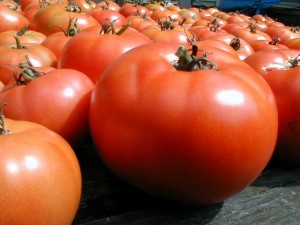
The tide has shifted in our kitchen garden. After the long wait for the first tomato to ripen, we find ourselves smack dab in the middle of a tomato deluge. You may have also grown too many tomatoes or found yourself carried away when purchasing at the farmers’ markets. Here are a few ways to enjoy all of your tomatoes to the maximum.
1. Eat tomatoes fresh or barely cooked.
Mid-summer is too hot for lengthy cooking and little preparation is needed for tomato consumption. Jim often skips washing them and eats tomatoes still warm from the sun while standing in the garden — one of the greatest things about organic gardening. If neatness counts, slice or chop your tomato first and sprinkle on a little salt. Just slightly more work, add a drizzle of olive oil and a sprinkling of fresh or dried herbs and now you have a classy snack or side dish. Toss on some cheese — feta or bleu — and you can call it a salad. With further preparation, you could enjoy tabbouleh. We like these two easy and fast tomato sauces adapted from Jane Brody’s Good Food Book.
Fresh Tomato and Basil Sauce
2 cloves garlic
1 cup peeled and seeded tomatoes
3 tablespoons minced fresh basil leaves
2 teaspoons olive oil
½ teaspoon salt
Several dashes cayenne1. In a blender, purée the garlic and tomato. Put the mixture in a non-metal bowl.
2. Stir in the basil, oil, salt and cayenne. Serve at room temperature on pasta, cold steamed vegetables, cold cooked chicken or fish, or hot rice.Marinara Sauce
2 lbs peeled tomatoes
2 teaspoons olive oil
4 cloves of minced garlic
1 – 6 ounce can of tomato paste
1-1/4 teaspoons oregano
Salt, to taste
Black pepper, to taste
1/3 cup minced fresh parsley1. Purée the tomatoes in a food mill, blender or food processor.
2. Heat the oil briefly and add the garlic. Sauté the garlic, stirring it for 15 seconds, but do not let it brown. Add the puréed tomatoes, tomato paste, oregano, salt and pepper. Bring the sauce to a boil, reduce the heat and simmer the sauce for 20 minutes.
3. Remove from the heat and stir in the parsley.
2. Preserve for later.
Canning tomatoes is the best place to start if you are interested in learning to can. Anyone with motivation can learn to can by carefully following the guidelines in the Ball Blue Book: Guide to Home Canning, Freezing and Hydration. Most tomatoes and especially heirloom varieties tend to be high in acid and hence resistant to spoilage. Our favored method of preserving tomatoes is canning a not-too-thick tomato sauce that we can simmer further in soups or spaghetti sauces in the fall and winter. To get a smooth sauce, we use a food mill that we purchased at a garage sale for $1, but nicer ones can be had at Downtown Home and Garden or Williams & Sonoma, if you aren’t so lucky. Weather too hot for lengthy cooking sessions is also unsuitable for the boiling water of canning, so you might save that technique for later in the season and instead consider freezing a quart or two of sauce. We have also had good luck with freezing tomatoes whole in Ziploc bags or plastic containers to cook later on.
3. Share your bounty.
The best thing about having too many tomatoes or any vegetable is that you can feel generous and share. One neighbor whose partner gardens only native plants seems especially appreciative of receiving some of our heirloom tomatoes. I had a co-worker who would send out a morning email announcement about the fresh herbs she’d brought from her garden to share that day.
If you have a lot to share or want to provide goodness from your garden to those in need, be aware that Food Gatherers accepts produce donations from home gardeners. You can make your donation in two ways. Produce can be dropped off at the Food Gatherers Warehouse at 1 Carrot Way, near Dhu Varren and Pontiac Trail. The hours are 9 a.m. to 4 p.m. Monday, Tuesday, Thursday and Friday, and 9 a.m. to 7 p.m. on Wednesday. You can also take your donations to English Gardens at 155 N. Maple Road during regular store hours, (Monday-Saturday 9 a.m. to 9 p.m., Sunday 9 a.m. to 6 p.m.). English Gardens will store your produce in their cooler and notify Food Gathers to arrange a pickup. Donations of any freshly picked vegetables, fruits and herbs are appreciated.
The days of too many tomatoes pass quickly. What are your favorite ways to enjoy your tomato bounty?



One Response
Stay in touch with the conversation, subscribe to the RSS feed for comments on this post.
Continuing the Discussion